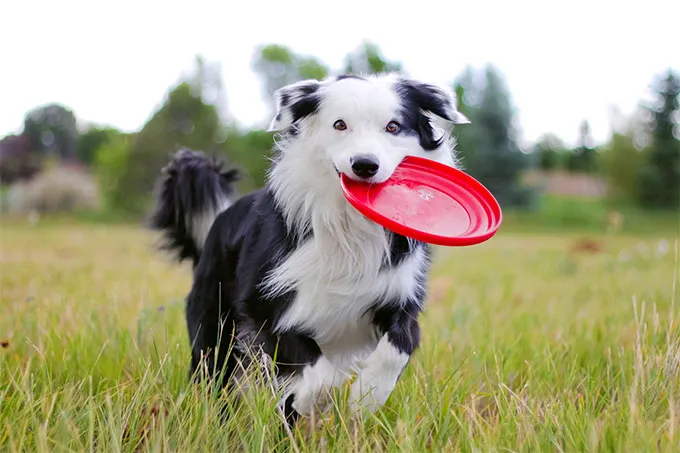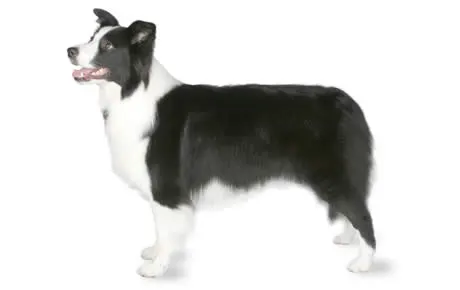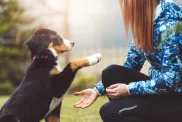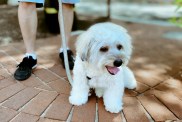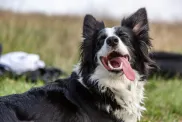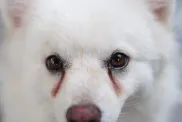The Border Collie dog breed was developed to gather and control sheep in the hilly border country between Scotland and England. They’re known for their intense stare, or “eye,” with which they control their flock. They’re dogs with unlimited energy, stamina, and working drive, all of which make them a premier herding dog; Border Collies are still used today to herd sheep on farms and ranches around the world.
Even though these are purebred dogs, you may find them in the care of shelters or rescue groups. Remember to adopt! Don’t shop if you want to bring a dog home.
The highly trainable and intelligent, Border Collies also excel in various canine sports, including obedience, flyball, agility, tracking, and flying disc competitions. They can make for great family companions, so long as they get a lot — a lot! — of physical and mental exercise. You’ll also have to be comfortable with a dog who can outsmart you from time to time. If you want a loving, brainy dog who will keep you active and on your toes, this may be the breed for you!
See below for complete list of dog breed traits and facts about Border Collies!
Border Collie Dog Breed Pictures
Adaptability
-
Adapts Well To Apartment Living
Looking for the best dog for your apartment? Contrary to popular belief, the suitability of dogs who adapt well to apartment living goes beyond its size. Apartment dwellers have a myriad of dog breeds to choose from as potential companions, with various factors to consider. Some large breeds can adapt well to apartment living and have lower activity levels. Others may require more space and possess higher energy levels. On the other hand, certain small dog breeds with abundant energy can still find contentment with indoor playtime or brisk walks.
However, when selecting a dog that adapts well apartments, it is essential to prioritize your neighbors. Opting for a pet that doesn’t excessively bark and behaves politely when encountering others in shared spaces like is crucial for maintaining a harmonious apartment environment.
In high-rise settings, it’s worth noting that numerous small dogs may exhibit a propensity for high energy and frequent barking. This makes them less suitable for apartment living. Therefore, desirable qualities in an apartment dog encompass being quiet, low-energy, and displaying polite behavior towards other residents.
Factors To Consider When Choosing A Dog For An Apartment
When considering dogs that adapt well to apartments, size alone should not be the sole determinant. Apartment dwellers have a wealth of dog breeds to choose from as potential furry companions. It’s important to remember that the size of your living space is just one factor to consider. While some larger breeds can adapt well to apartment living, with lower, others may require more space and have higher energy levels, making them less suitable for smaller apartments. Conversely, certain small dog breeds with higher energy levels can still thrive in apartments, finding contentment through indoor playtime or brisk walks. However, it is crucial to consider your neighbors’ comfort when selecting a dog. Opt for a pet that doesn’t bark excessively and behaves politely when interacting with others in shared spaces.
Therefore, it’s important to prioritize qualities such as being quiet, low-energy, calm indoors, and exhibiting good manners when living in close proximity to other residents. By considering these factors, you can find a dog that will adapt well to apartment living and create a harmonious living environment for everyone involved.
-
Good For Novice Owners
Some dogs are simply easier than others; they take to training better and are fairly easygoing. They’re also resilient enough to bounce back from your mistakes or inconsistencies.
Dogs who are highly sensitive, independent thinking, or assertive may be harder for a first-time dog parent to manage. You’ll get your best match if you take your dog-owning experience into account as you choose your new pooch.
If you’re new to dog parenting, take a look at 101 Dog Tricks and read up on how to train your dog!
-
Sensitivity Level
Some dogs will let a stern reprimand roll off their backs, while others take even a dirty look to heart. Low-sensitivity dogs, also called “easygoing,” “tolerant,” “resilient,” and even “thick-skinned,” can better handle a noisy, chaotic household, a louder or more assertive owner, and an inconsistent or variable routine. Do you have young kids, throw lots of dinner parties, play in a garage band, or lead a hectic life? Go with a low-sensitivity dog.
-
Tolerates Being Alone
Some breeds bond very closely with their family and are more prone to worry or even panic when left alone by their owner. An anxious dog can be very destructive–barking, whining, chewing, and otherwise causing mayhem. These breeds do best when a family member is home during the day or if you can take the dog to work.
-
Tolerates Cold Weather
Breeds with very short coats and little or no undercoat or body fat, such as Greyhounds, are vulnerable to the cold. Dogs with a low cold tolerance need to live inside in cool climates and should have a jacket or sweater for chilly walks. You can find a great jacket for your dog here!
-
Tolerates Hot Weather
Dogs with thick, double coats are more vulnerable to overheating. So are breeds with short noses, like Bulldogs or Pugs, since they can’t pant as well to cool themselves off. If you want a heat-sensitive breed, your dog will need to stay indoors with you on warm or humid days, and you’ll need to be extra cautious about exercising your dog in the heat.
All-around friendliness
-
Affectionate With Family
When it comes to unconditional love and unwavering loyalty, few animals can rival the affectionate nature of dogs. These remarkable creatures have earned their reputation as man’s best friend, and many breeds are particularly renowned for their love and devotion to their families. With their warm hearts and wagging tails, affectionate family dogs enrich the lives of their owners in countless ways.
One such breed known for its affectionate demeanor is the Golden Retriever. With their gentle temperament and friendly disposition, Golden Retrievers form deep bonds with their families. They eagerly participate in family activities, whether it’s a game of fetch in the yard or cuddling on the couch during a movie night. Their expressive eyes and ever-wagging tails are a testament to the joy they feel in the presence of their loved ones.
Another family-favorite breed is the Labrador Retriever. Renowned for their playful and patient nature, Labradors are excellent companions for children and adults alike. They readily engage in playtime with the kids, showcasing their boundless energy and enthusiasm. But when the day winds down, they seamlessly transition into loving and gentle cuddle buddies, comforting their family members with their warm presence.
Beyond specific breeds, mixed-breed dogs also have a special place in the hearts of families seeking affectionate companions. The shelter dogs, in particular, form deep connections with their adoptive families. They seem to understand the second chance they’ve been given and repay it with endless love and gratitude.
How To Know If A Dog Is Good With Families
The affectionate nature of family dogs extends beyond play and cuddles. Dogs have a remarkable ability to sense their owner’s emotions, offering comfort and support during difficult times. Whether it’s a wagging tail after a long day at work or a sympathetic nuzzle during moments of sadness, they prove time and again that they are attuned to their family’s needs.
It is important to note that not all dogs of the same breed will be equally affectionate. Some dogs may be more independent or aloof, while others may be more clingy or demanding of attention. The best way to find out how affectionate a dog is is to meet them in person and interact with them.
-
Kid-Friendly
Being gentle with children, sturdy enough to handle the heavy-handed pets and hugs they can dish out, and having a blasé attitude toward running, screaming children are all traits that make a kid-friendly dog. You may be surprised by who’s on that list: Fierce-looking Boxers are considered good with children, as are American Staffordshire Terriers (which are considered Pit Bulls). Small, delicate, and potentially snappy dogs such as Chihuahuas aren’t always so family-friendly.
**All dogs are individuals. Our ratings are generalizations, and they’re not a guarantee of how any breed or individual dog will behave. Dogs from any breed can be good with children based on their past experiences, training on how to get along with kids, and personality. No matter what the breed or breed type, all dogs have strong jaws, sharp pointy teeth, and may bite in stressful circumstances. Young children and dogs of any breed should always be supervised by an adult and never left alone together, period.
-
Dog Friendly
Friendliness toward dogs and friendliness toward humans are two completely different things. Some dogs may attack or try to dominate other dogs, even if they’re love-bugs with people; others would rather play than fight; and some will turn tail and run. Breed isn’t the only factor. Dogs who lived with their littermates and mother until at least six to eight weeks of age and who spent lots of time playing with other dogs during puppyhood, are more likely to have good canine social skills.
-
Friendly Toward Strangers
Stranger-friendly dogs will greet guests with wagging tails and nuzzles; others are shy, indifferent, or even aggressive. However, no matter what the breed, a dog who was socialized and exposed to lots of different types, ages, sizes, and shapes of people as a puppy will respond better to strangers as an adult. Remember that even friendly dogs should stay on a good, strong leash like this one in public!
Health And Grooming Needs
-
Amount Of Shedding
If you’re going to share your home with a dog, you’ll need to deal with some level of dog hair on your clothes and in your house. However, shedding does vary greatly among the breeds. Some dogs shed year-round, some “blow” seasonally, some do both, and some shed hardly at all. If you’re a neatnik, you’ll need to either pick a low-shedding breed or relax your standards. To help keep your home a little cleaner, you can find a great de-shedding tool here!
-
Drooling Potential
Drool-prone dogs may drape ropes of slobber on your arm and leave big, wet spots on your clothes when they come over to say hello. If you’ve got a laid-back attitude toward slobber, fine; but if you’re a neatnik, you may want to choose a dog who rates low in the drool department.
-
Easy To Groom
Some breeds are brush-and-go dogs; others require regular bathing, clipping, and other grooming just to stay clean and healthy. Consider whether you have the time and patience for a dog who needs a lot of grooming, or the money to pay someone else to do it.
-
General Health
Due to poor breeding practices, some breeds are prone to certain genetic health problems, such as hip dysplasia. This doesn’t mean that every dog of that breed will develop those diseases; it just means that they’re at an increased risk.
If you’re adopting a puppy, it’s a good idea to find out which genetic illnesses are common to the breed you’re interested in. You may also want to ask if your shelter or rescue has information about the physical health of your potential pup’s parents and other relatives.
-
Potential For Weight Gain
Some breeds have hearty appetites and tend to put on weight easily. As in humans, being overweight can cause health problems in dogs. If you pick a breed that’s prone to packing on pounds, you’ll need to limit treats, make sure they get enough exercise, and measure out their daily food servings into regular meals rather than leaving food out all the time.
Ask your vet about your dog’s diet and what they recommend for feeding your pooch to keep them at a healthy weight. Weight gain can lead to other health issues or worsen problems like arthritis.
-
Size
Get ready to meet the giants of the doggy world! Large dog breeds aren’t just big balls of fluff, they’re like loving, oversized teddy bears on a mission to steal your heart. Need some convincing? Let’s dive into the awesome benefits of owning one!
First things first, these pooches are a living security system! With their impressive size and thunderous barks, they’ll have any would-be intruder running for the hills. Talk about peace of mind! Plus, who needs an alarm when you’ve got a furry giant protecting your castle?
But that’s not all. Large dog breeds are all about loyalty and devotion. They’ll stick by your side through thick and thin, becoming your most dedicated bestie. Their love knows no bounds! When you have a giant fluffball showing you unconditional love, you’ll feel like the luckiest human on the planet.
Now, let’s talk about their talents. These big fellas are the ultimate working partners. With brains and brawn, they’re up for any challenge. From search and rescue missions to lending a helping paw to those in need, these dogs are superheroes in fur coats. They’ll make you proud every step of the way!
Don’t let their size fool you—these gentle giants have hearts as big as their paws. They’re incredible with kids and other pets, spreading their love like confetti. Their patience and kindness make them perfect family pets, ensuring harmony in your household.
Oh, and get ready to break a sweat! These dogs are fitness enthusiasts, and they’ll keep you on your toes. Daily walks, jogs, and play sessions will not only keep them happy and healthy but will also give you a reason to ditch the couch and join in on the fun. It’s a win-win situation!
So, if you’re ready for a dose of big love, go ahead and consider a large dog breed. They’re the best wing-dog you could ever ask for, ready to make your life a thousand times more exciting, loving, and downright awesome! Get ready for the big adventure of a lifetime!
Trainability
-
Easy To Train
Easy-to-train dogs are more adept at forming an association between a prompt (such as the word “sit”), an action (sitting), and a consequence (getting a treat) very quickly. Other dogs need more time, patience, and repetition during training.
Many breeds are intelligent but approach training with a “What’s in it for me?” attitude, in which case you’ll need to use rewards and games to teach them to want to comply with your requests.
Related:
10 Fun, Impressive Tricks You Can Teach Any Dog
-
Intelligence
Dogs who were bred for jobs that require decision making, intelligence, and concentration, such as herding livestock, need to exercise their brains, just as dogs who were bred to run all day need to exercise their bodies. If they don’t get the mental stimulation they need, they’ll make their own work–usually with projects you won’t like, such as digging and chewing. Obedience training and interactive dog toys are good ways to give a dog a brain workout, as are dog sports and careers, such as agility and search and rescue.
-
Potential For Mouthiness
Common in most breeds during puppyhood and in Retriever breeds at all ages, mouthiness means a tendency to nip, chew, and play-bite (a soft, fairly painless bite that doesn’t puncture the skin). Mouthy dogs are more likely to use their mouths to hold or “herd” their human family members, and they need training to learn that it’s fine to gnaw on chew toys, but not on people. Mouthy breeds tend to really enjoy a game of fetch, as well as a good chew on a toy that’s been stuffed with kibble and treats.
-
Prey Drive
Dogs with a high prey drive have an instinctive desire to stalk, capture, and prey upon potential food sources. Dogs who were bred to hunt, such as Terriers, have an inborn desire to chase — and sometimes kill — other animals. Anything whizzing by — such as cats, squirrels, and perhaps even cars — can trigger that instinct.
How to address a high prey drive
Off-leash adventures are too great a temptation for pups who will wander and hunt. Dogs who like to chase need to be leashed. And, even on a leash, you may experience your dog pulling on the leash to reach rodents or birds in their sight. Otherwise, these pups should be kept in a fenced area when outdoors. If your pup has a high prey drive, you’ll need a high, secure fence in your yard.
These breeds generally aren’t a good fit for homes with smaller pets that can look like prey, such as cats, hamsters, or small dogs. Breeds that were originally used for bird hunting, on the other hand, generally won’t chase, but you’ll probably have a hard time getting their attention when there are birds flying by.
Other behavioral concerns
Observing your dog’s prey drive, which is instinctual and biologically-rooted, is not the same as observing aggression. Much aggression is born of fear and anxiety, especially in the case of dog aggression toward humans.
The tendency to wander, even into oncoming traffic, can produce diasterious results for pups with predatory instincts. It can also lead to pups being bitten by snakes or attacked by other wild animals they may pursue while on the hunt.
-
Tendency To Bark Or Howl
Some breeds sound off more often than others. When choosing a breed, think about how often the dog vocalizes. Learn more about breeds with a tendency to bark or howl.
If you’re considering a hound, would you find their trademark howls musical or maddening? If you’re considering a watchdog, will a city full of suspicious “strangers” put your pup on permanent alert? Will the local wildlife literally drive your dog wild? Do you live in housing with noise restrictions? Do you have neighbors nearby? Then you may wish to choose a quieter dog.
-
Wanderlust Potential
Some breeds are more free-spirited than others. Nordic dogs such as Siberian Huskies were bred to range long distances, and given the chance, they’ll take off after anything that catches their interest. And many hounds simply must follow their noses–or that bunny that just ran across the path–even if it means leaving you behind.
Exercise needs
-
Energy Level
High-energy dogs are always ready and waiting for action. Originally bred to perform a canine job of some sort, such as retrieving game for hunters or herding livestock, they have the stamina to put in a full workday. They need a significant amount of exercise and mental stimulation, and they’re more likely to spend time jumping, playing, and investigating any new sights and smells.
Low-energy dogs are the canine equivalent of a couch potato, content to doze the day away. When picking a breed, consider your own activity level and lifestyle, and think about whether you’ll find a frisky, energetic dog invigorating or annoying.
-
Intensity
A vigorous dog may or may not have high energy, but everything they do, they do with vigor: they strain on the leash (until you train them not to), try to plow through obstacles, and even eats and drinks with great big gulps. These dynamos need lots of training to learn good manners, and may not be the best fit for a home with young kids or someone who’s elderly or frail. A low-vigor dog, on the other hand, has a more subdued approach to life.
-
Exercise Needs
Some breeds do fine with a slow evening stroll around the block. Others need daily, vigorous exercise, especially those that were originally bred for physically demanding jobs, like herding or hunting.
Without enough exercise, these breeds may put on weight and vent their pent-up energy in ways you don’t like, such as barking, chewing, and digging. Breeds that need a lot of exercise are good for outdoorsy, active people, or those interested in training their dog to compete in a high-energy dog sport, such as agility.
-
Potential For Playfulness
Some dogs are perpetual puppies — always begging for a game — while others are more serious and sedate. Although a playful pup sounds endearing, consider how many games of fetch or tag you want to play each day, and whether you have kids or other dogs who can stand in as playmates for the dog.
Border Collie Overview
If you’ve ever had the pleasure of watching a Border Collie herd sheep, you know you’re watching a master craftsman at work, with his intense stare as he approaches the sheep, his almost intuitive response to the shepherd’s command, and the skillful manner in which he maneuvers the sheep exactly where the shepherd wants them to go. It is awe-inspiring.
The Border Collie, a medium-sized dog at 30 to 45 pounds, possesses a seemingly supernatural amount of energy and stamina — a hardiness that was developed when he was required to work all day in the hills and valleys of the rugged Scottish border country, sometimes running 50 miles or more a day. When it comes to the ideal working dog, it doesn’t get much better than the Border Collie.
If there is a dark side to the Border Collie’s energy and workaholic attitude, it comes out when he’s brought into a family that doesn’t understand him. He is not a cuddly, couch-potato dog. He doesn’t want to be coddled. He wants — and needs — a job. Keeping up with the Border Collie’s intense mental and physical stamina is exhausting, even exasperating, to an owner or family that wants a laid-back family pet.
The Border Collie is a herding dog, which means he has an overwhelming urge to gather a flock. That flock could be sheep, children, cats, squirrels, or anything that moves, including cars. This instinct to nip, nudge, and bark, along with his energy, cannot be trained out of him. Rather, it must be directed. He must have a task, whether it’s actually herding sheep or competing in dog sports. A brisk walk or a game of fetch every day isn’t enough activity for the Border Collie.
That said, for the right owner, a Border Collie is a wonderful dog to live with. His intelligence and tractable nature make him easy to train. He’s sensitive and, according to those who know him well, he has an uncanny ability to know what you’re going to ask of him before you ask it. If he is well socialized and trained from puppyhood, he can adapt to almost any living situation that provides the mental and physical exercise he requires.
The Border Collie is a good match for an owner who is as active as he is, especially one who’s eager to get involved in dog sports. With the right training, this breed excels in any activity he tries, including sheepdog trials, agility, flyball, flying disc, advanced obedience, freestyle obedience, or tracking.
The owner or family that’s willing to properly socialize and train the Border Collie will find a soul mate in this intelligent, sensitive breed.
Border Collie Highlights
- The Border Collie is highly sensitive, often responsive to the subtlest command and seemingly able to predict his owner’s desires in advance.
- A workaholic who thrives on mental and physical stimulation, the Border Collie must have a positive way to direct his energy. Otherwise he’ll invent his own games — and he can become a problem to live with.
- The Border Collie will herd anything that moves, including children, cars, people on bikes, cats, and squirrels. He can become a real problem if he’s allowed to roam in a neighborhood; a securely fenced yard is essential.
- The noisy play of young children can stimulate the Border Collie’s herding instinct and cause him to nip, nudge, and bark.
- To prevent shyness, the Border Collie must be well socialized.
- The Border Collie doesn’t usually roam, but his curiosity and intelligence can lead him to become an escape artist.
- To get a healthy dog, never buy a puppy from an irresponsible breeder, puppy mill, or pet store. Look for a reputable breeder who tests her breeding dogs to make sure they’re free of genetic diseases that they might pass onto the puppies, and that they have sound temperaments.
Border Collie History
The Border Collie’s ancestors have been around since humans in what is now Britain first began using dogs to help guard and herd sheep. In the border country between Scotland and England, the herding dog became one of the most valuable assets a shepherd could have, and the best working dogs were bred with each other.
The type varied, depending on the terrain or the work required in each region. These herding dogs became associated with their particular regions and were eventually known as Welsh Sheepdogs, Northern Sheepdogs, Highland Collies, and Scotch Collies. The Border Collie’s name reflects his partially Scottish heritage: the word collie, which refers to sheepdogs, is derived from Scottish dialect.
In 1860, Scotch Sheep Dogs were shown at the second dog show ever held in England. On a trip to Balmoral a short time later, Queen Victoria saw one of the dogs and became an enthusiast of the breed.
One R.J. Lloyd Price is given credit for beginning sheepdog trials. In 1876, he brought 100 wild Welsh sheep to the Alexandra Palace in London for a demonstration. An account in the Livestock Journal described the astonishment of the spectators at the keenness of the dogs, whose only assistance from their handlers was in the form of hand signals and whistles.
Today the Border Collie is recognized as the premier sheepherding dog. The breed’s superior herding ability leads many fanciers to advocate breeding Border Collies only to working, not conformation, standards. The Border Collie was recognized by the American Kennel Club on October 1, 1995.
Border Collie Size
Males stand 19 to 22 inches tall and weigh 35 to 45 pounds. Females stand 18 to 21 inches and weigh 30 to 40 pounds.
Border Collie Personality
Quite simply, the Border Collie is a dynamo. His personality is characteristically alert, energetic, hardworking, and smart. He learns quickly — so quickly that it’s sometimes difficult to keep him challenged.
This breed likes to be busy. In fact, he must be busy or he becomes bored, which leads to annoying behavior, such as barking, digging, or chasing cars. He’s not a dog to lie quietly on the front porch while you sip a glass of lemonade; he thrives on activity. Remember, he was bred to run and work all day herding sheep.
The Border Collie is also renowned for being highly sensitive to his handler’s every cue, from a whistle to a hand signal to a raised eyebrow.
Of course, the Border Collie isn’t perfect. He can be strong-minded and independent, and his compulsion to herd can become misdirected. In the absence of sheep, or some kind of job, he is apt to gather and chase children, cars, or pets.
He can also become fearful or shy if he isn’t properly socialized as a puppy. Puppy classes and plenty of exposure to a variety of people, places, and things help the sensitive Border Collie gain confidence.
Border Collie Health
Border Collies are generally healthy, but like all breeds, they’re prone to certain health conditions. Not all Border Collies will get any or all of these diseases, but it’s important to be aware of them if you’re considering this breed.
If you’re buying a puppy, find a good breeder who will show you health clearances for both your puppy’s parents. Health clearances prove that a dog has been tested for and cleared of a particular condition.
In Border Collies, you should expect to see health clearances from the Orthopedic Foundation for Animals (OFA) for hip dysplasia (with a score of fair or better), elbow dysplasia, hypothyroidism, and von Willebrand’s disease; from Auburn University for thrombopathia; and from the Canine Eye Registry Foundation (CERF) certifying that eyes are normal. You can confirm health clearances by checking the OFA web site (offa.org).
- Hip Dysplasia: This is an inherited condition in which the thighbone doesn’t fit snugly into the hip joint. Some dogs show pain and lameness on one or both rear legs, but others don’t display outward signs of discomfort. (X-ray screening is the most certain way to diagnose the problem.) Either way, arthritis can develop as the dog ages. Dogs with hip dysplasia should not be bred — so if you’re buying a puppy, ask the breeder for proof that the parents have been tested for hip dysplasia and are free of problems.
- Progressive Retinal Atrophy (PRA): This is a family of eye diseases that involves the gradual deterioration of the retina. Early in the disease, affected dogs become night-blind; they lose sight during the day as the disease progresses. Many affected dogs adapt well to their limited or lost vision, as long as their surroundings remain the same.
- Epilepsy: This is a neurological condition that’s often, but not always, inherited. Epilepsy can cause mild or severe seizures that may show themselves as unusual behavior (such as running frantically as if being chased, staggering, or hiding) or even by falling down, limbs rigid, and losing consciousness. Seizures are frightening to watch, but the long-term prognosis for dogs with idiopathic epilepsy is generally very good. It’s important to take your dog to the vet for proper diagnosis (especially since seizures can have other causes) and treatment.
- Collie Eye Anomaly: This is an inherited condition that causes changes and abnormalities in the eye, which can sometimes lead to blindness. These changes can include choroidal hypoplasia (an abnormal development of the choroids), coloboma (a defect in the optic disc), staphyloma (a thinning of the sclera), and retinal detachment. Collie eye anomaly usually occurs by the time the dog is two years old. There is no treatment for the condition.
- Allergies: There are three main types of allergies in dogs: food allergies, which are treated by eliminating certain foods from the dog’s diet; contact allergies, which are caused by a reaction to a topical substance such as bedding, flea powders, dog shampoos, and other chemicals; and inhalant allergies, which are caused by airborne allergens such as pollen, dust, and mildew. Treatment varies according to the cause and may include dietary restrictions, medications, and environmental changes.
- Osteochondrosis Dissecans (OCD): This orthopedic condition, caused by improper growth of cartilage in the joints, usually occurs in the elbows, but it has been seen in the shoulders as well. It causes a painful stiffening of the joint, to the point that the dog is unable to bend his elbow. It can be detected in dogs as early as four to nine months of age. Overfeeding of “growth formula” puppy foods or high-protein foods may contribute to its development.
Border Collie Care
While the Border Collie is a highly adaptable dog, he’s best suited to an environment that gives him some elbow room: a city home with a securely fenced yard, or a country farm or ranch. Because he has a propensity to herd and chase, he must be protected from his not-so-bright instinct to chase cars.
Regardless of the environment, he requires a great deal of mental and physical stimulation every day, and he needs an owner who is willing and able to provide that. This can be a great burden to owners who don’t know what they’re getting into. If you’re considering a Border Collie, make sure you can provide him with a proper outlet for his natural energy and bright mind. If you don’t have a farm with sheep, dog sports are a good alternative.
Border Collie Feeding
Recommended daily amount: 1.5 to 2 cups of high-quality dry food a day, divided into two meals.
NOTE: How much your adult dog eats depends on his size, age, build, metabolism, and activity level. Dogs are individuals, just like people, and they don’t all need the same amount of food. It almost goes without saying that a highly active dog will need more than a couch potato dog. The quality of dog food you buy also makes a difference — the better the dog food, the further it will go toward nourishing your dog and the less of it you’ll need to shake into your dog’s bowl.
For more on feeding your Border Collie, see our guidelines for buying the right food, feeding your puppy, and feeding your adult dog
.
Border Collie Coat Color And Grooming
The Border Collie breed boasts two varieties of coat: rough and smooth. Both are double coats, with a coarser outer coat and soft undercoat. The rough variety is medium length with feathering on the legs, chest, and belly. The smooth variety is short all over, usually coarser in texture than the rough variety, and feathering is minimal.
His coat is most often black with a white blaze on the face, neck, feet, legs, and tail tip, with or without tan. However, he may be any bicolor, tricolor, merle, or solid color except white.
The hardworking Border Collie isn’t prissy, and he doesn’t need excessive grooming to keep him looking good. His weather-resistant double coat needs weekly brushing to keep coat oils well distributed, and to prevent matting in the rough variety. More frequent brushing during shedding season is a good idea to minimize hair shed around the house (he sheds seasonally). Bathe only as needed — about every four months or when he’s really dirty or smells terrible.
Brush your Border Collie’s teeth at least two or three times a week to remove tartar buildup and the bacteria that lurk inside it. Daily brushing is even better if you want to prevent gum disease and bad breath.
Trim his nails once a month if needed, and check his ears once a week for dirt, redness, or a bad odor that can indicate an infection. Then wipe them out weekly with a cotton ball dampened with gentle, pH-balanced ear cleaner to prevent problems.
As you groom, check for sores, rashes, or signs of infection such as redness, tenderness, or inflammation on the skin, in the nose, mouth, and eyes, and on the feet. Eyes should be clear, with no redness or discharge. Your careful weekly exam will help you spot potential health problems early.
Border Collie Children And Other Pets
The Border Collie is a good family dog, as long as he is raised properly and receives training when he’s young. He gets along with children and other pets, though his instinct to herd will cause him to nip, chase, and bark at kids (especially very young children) and animals if his herding instincts aren’t otherwise directed.
As with every breed, you should always teach children how to approach and touch dogs, and always supervise any interactions between dogs and young children to prevent any biting or ear or tail pulling on the part of either party. Teach your child never to approach any dog while he’s eating or sleeping or to try to take the dog’s food away. No dog, no matter how friendly, should ever be left unsupervised with a child.
Border Collie Rescue Groups
Border Collies are often purchased without any clear understanding of what goes into owning one. There are many Border Collies in need of adoption and or fostering. There are a number of rescues that we have not listed. If you don’t see a rescue listed for your area, contact the national breed club or a local breed club and they can point you toward a Border Collie rescue.
Border Collie Breed Organizations
Below are breed clubs, organizations, and associations where you can find additional information about the Border Collie.
Border Collie Dog Breed Pictures
-
Border Collie Dog Breed Picture
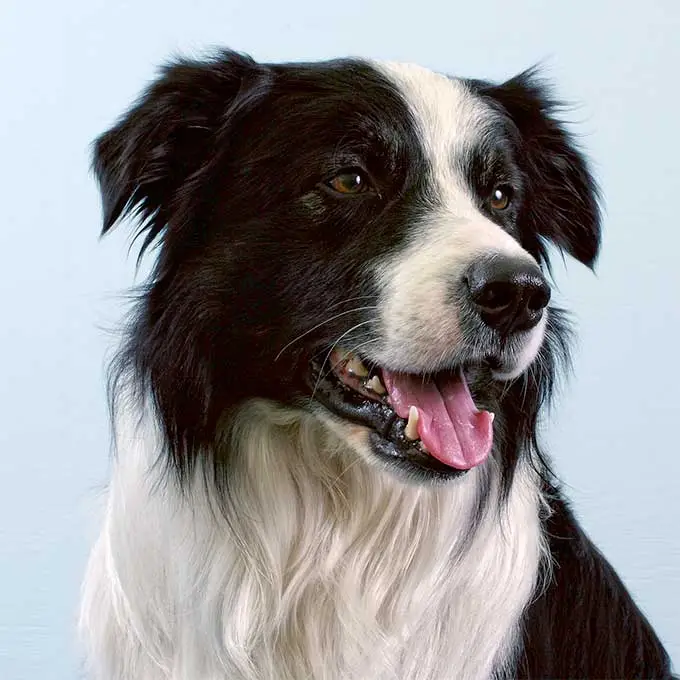
-
Border Collie Dog Breed Picture
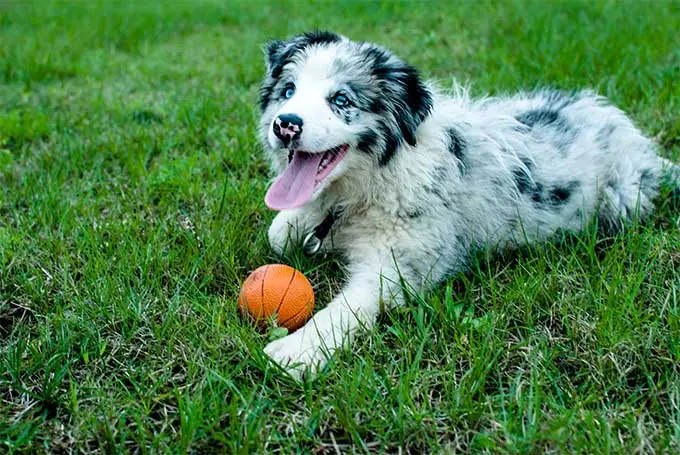
-
Border Collie Dog Breed Picture
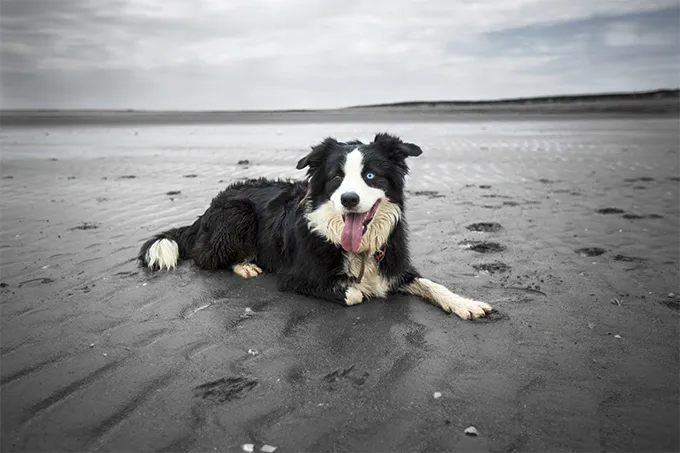
-
Border Collie Dog Breed Picture
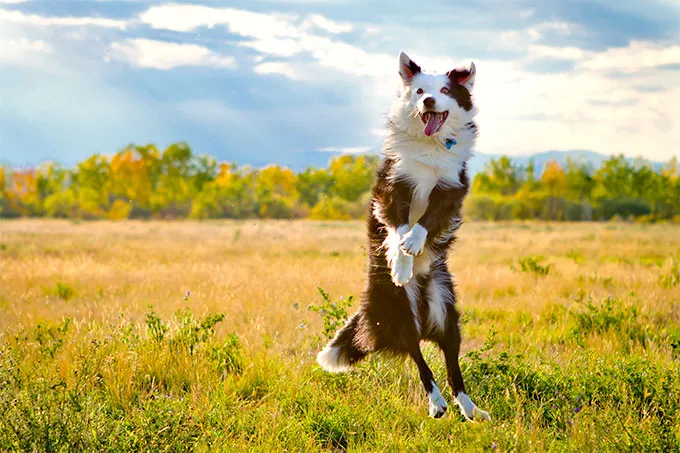
-
Border Collie Dog Breed Picture
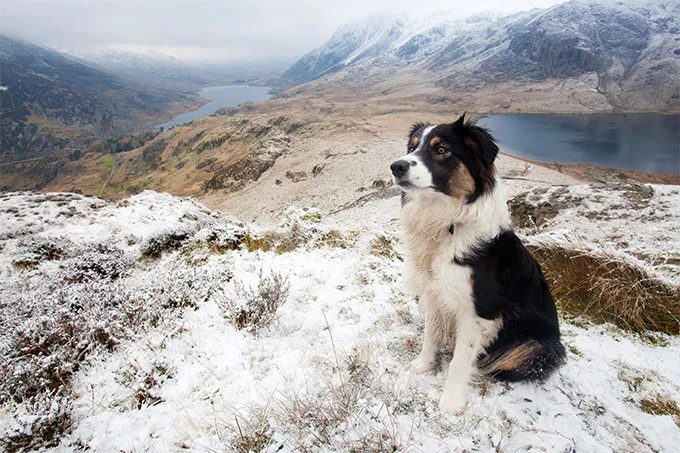
-
Border Collie Dog Breed Picture
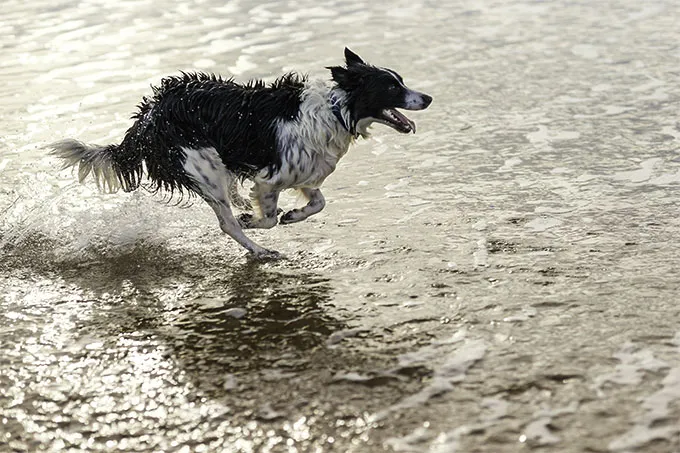
-
Border Collie Dog Breed Picture
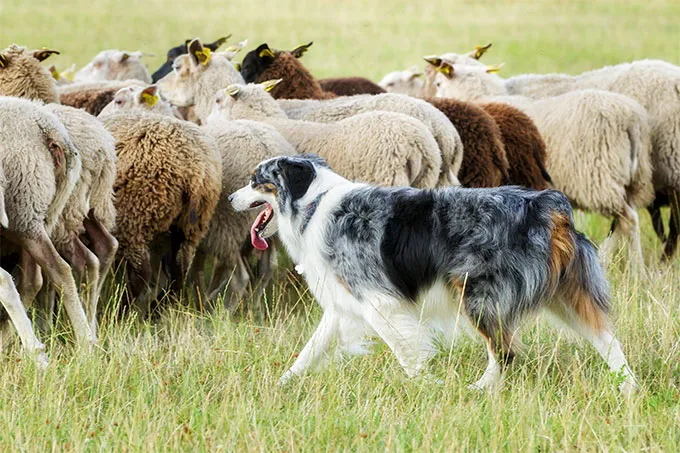
-
Border Collie Dog Breed Picture
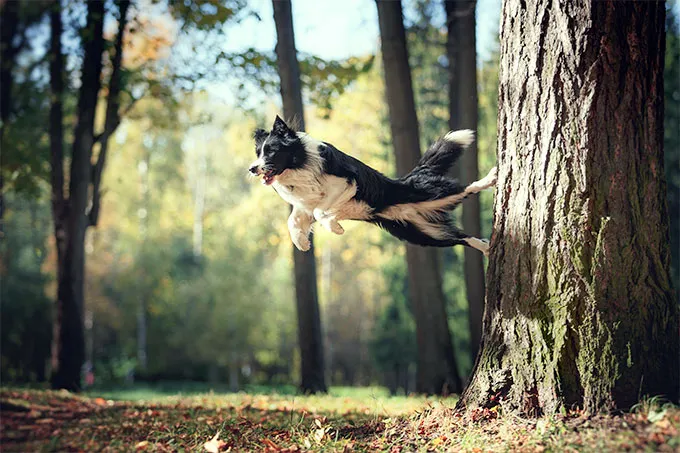
-
Border Collie Dog Breed Picture
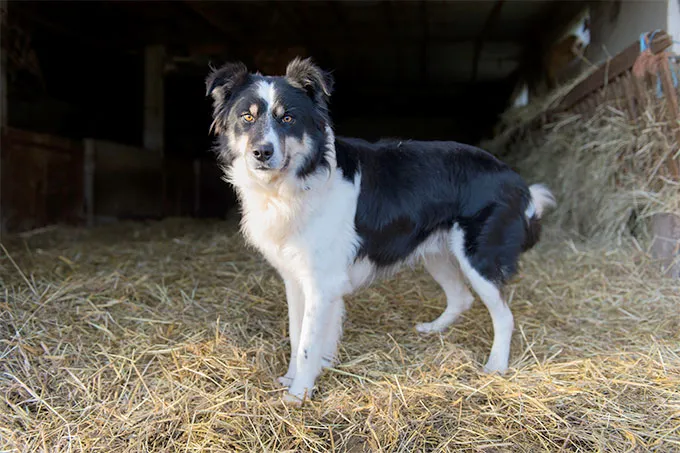
-
Border Collie Dog Breed Picture
